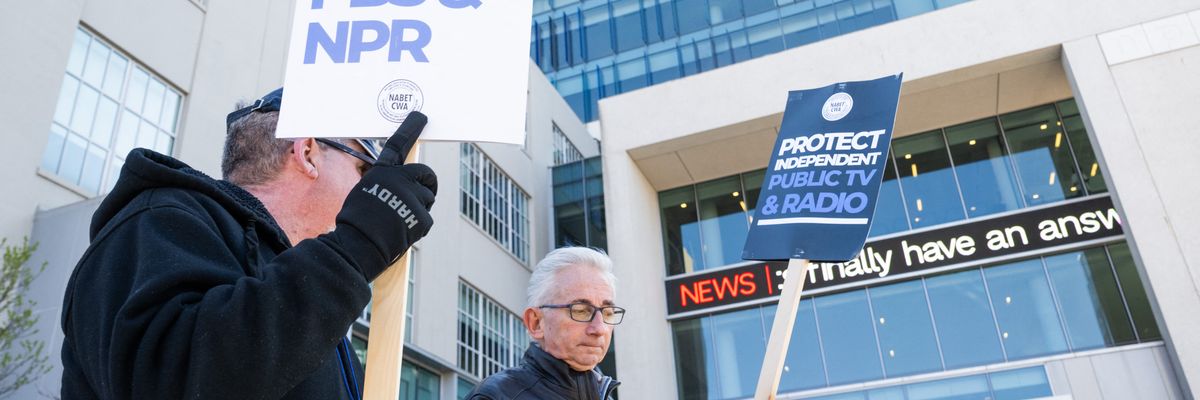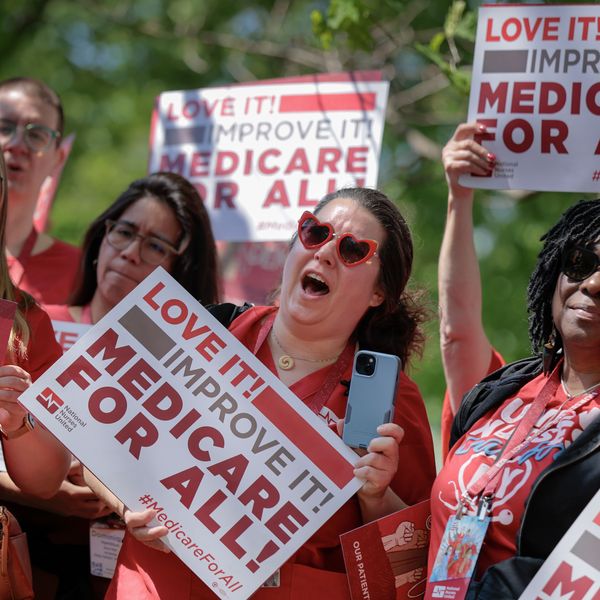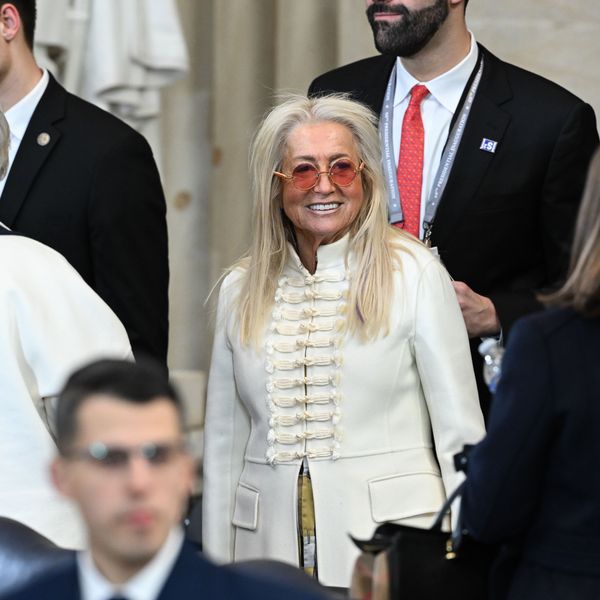
People participate in a rally to call on Congress to protect funding for U.S. public broadcasters in Washington, D.C., on March 26, 2025. (Photo: Saul Loeb/AFP via Getty Images)
PBS and NPR See Unprecedented Surge in Donations After GOP Votes for Defunding
"It is still early, and we hope the support will continue to grow," said the CEO of a firm that tracks and analyzes donations to public media.
Republicans in Congress may have voted to defund publicly funded media outlets in the United States, but American citizens are trying to fill the gap.
The New York Times reports that donations to public media have surged ever since the GOP voted to eliminate $550 million in annual funding for the Public Broadcasting Service (PBS) and National Public Radio (NPR).
Citing numbers from Contributor Development Partnership, a firm that provides analysis of public media fundraising data, the Times reports that donors this year have so far contributed $70 million more to NPR and PBS than they had done over the same period the year before. The numbers also show that "over the last three months, as the prospect of the cuts intensified, roughly 120,000 new donors have contributed an estimated $20 million in annual value," writes the Times.
Contributor Development Partnership CEO Michal Heiplik tells the Times that these donations, while impressive, are still a long way from being able to fill the $550 million hole left by GOP cuts.
"It is still early, and we hope the support will continue to grow," he said. "Next few weeks will be telling."
Heiplik also tells the Times that more donors in recent months have signed up to become sustaining members, which he says will be helpful in ensuring both entities have sustained finances instead of having to rely on one-time bursts of donations.
The vast majority of funding for public media has long come from donors, with only a small percentage coming from the federal government.
An Urgent Message From Our Co-Founder
Dear Common Dreams reader, The U.S. is on a fast track to authoritarianism like nothing I've ever seen. Meanwhile, corporate news outlets are utterly capitulating to Trump, twisting their coverage to avoid drawing his ire while lining up to stuff cash in his pockets. That's why I believe that Common Dreams is doing the best and most consequential reporting that we've ever done. Our small but mighty team is a progressive reporting powerhouse, covering the news every day that the corporate media never will. Our mission has always been simple: To inform. To inspire. And to ignite change for the common good. Now here's the key piece that I want all our readers to understand: None of this would be possible without your financial support. That's not just some fundraising cliche. It's the absolute and literal truth. We don't accept corporate advertising and never will. We don't have a paywall because we don't think people should be blocked from critical news based on their ability to pay. Everything we do is funded by the donations of readers like you. Will you donate now to help power the nonprofit, independent reporting of Common Dreams? Thank you for being a vital member of our community. Together, we can keep independent journalism alive when it’s needed most. - Craig Brown, Co-founder |
Republicans in Congress may have voted to defund publicly funded media outlets in the United States, but American citizens are trying to fill the gap.
The New York Times reports that donations to public media have surged ever since the GOP voted to eliminate $550 million in annual funding for the Public Broadcasting Service (PBS) and National Public Radio (NPR).
Citing numbers from Contributor Development Partnership, a firm that provides analysis of public media fundraising data, the Times reports that donors this year have so far contributed $70 million more to NPR and PBS than they had done over the same period the year before. The numbers also show that "over the last three months, as the prospect of the cuts intensified, roughly 120,000 new donors have contributed an estimated $20 million in annual value," writes the Times.
Contributor Development Partnership CEO Michal Heiplik tells the Times that these donations, while impressive, are still a long way from being able to fill the $550 million hole left by GOP cuts.
"It is still early, and we hope the support will continue to grow," he said. "Next few weeks will be telling."
Heiplik also tells the Times that more donors in recent months have signed up to become sustaining members, which he says will be helpful in ensuring both entities have sustained finances instead of having to rely on one-time bursts of donations.
The vast majority of funding for public media has long come from donors, with only a small percentage coming from the federal government.
Republicans in Congress may have voted to defund publicly funded media outlets in the United States, but American citizens are trying to fill the gap.
The New York Times reports that donations to public media have surged ever since the GOP voted to eliminate $550 million in annual funding for the Public Broadcasting Service (PBS) and National Public Radio (NPR).
Citing numbers from Contributor Development Partnership, a firm that provides analysis of public media fundraising data, the Times reports that donors this year have so far contributed $70 million more to NPR and PBS than they had done over the same period the year before. The numbers also show that "over the last three months, as the prospect of the cuts intensified, roughly 120,000 new donors have contributed an estimated $20 million in annual value," writes the Times.
Contributor Development Partnership CEO Michal Heiplik tells the Times that these donations, while impressive, are still a long way from being able to fill the $550 million hole left by GOP cuts.
"It is still early, and we hope the support will continue to grow," he said. "Next few weeks will be telling."
Heiplik also tells the Times that more donors in recent months have signed up to become sustaining members, which he says will be helpful in ensuring both entities have sustained finances instead of having to rely on one-time bursts of donations.
The vast majority of funding for public media has long come from donors, with only a small percentage coming from the federal government.

